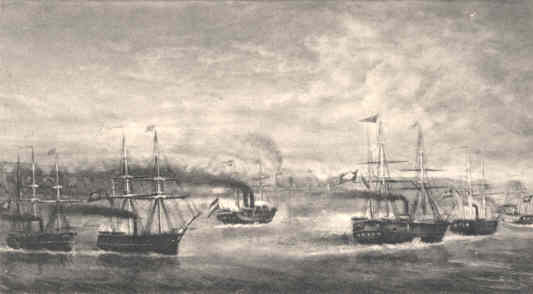 |
 |
 |
 |
 |
 |
 |
 |
 |
 |
 |
 |
 |
 |
 |
 |
 |
 |
 |
|
The Triple Alliance War
(1864-1870) |
|
|
| The Triple Alliance War was the most lasting and boodiest conflict ocurred in South America. |
|
The Imperial Navy had a important roll in the campaign. Both Argentina and Uruguay did not have national navies. Thus, the Brazilian Navy was responsible for the control of La Plata Basin and for the landing of troops and supplies on the conflict area.
When the conflict broke out, the navy had at disposal some 45 war vessels: 33 steamships and 12 sail vessels with 609 officers and 3.627 men. The major part of this force was deployed along La Plata region at the eve of the conflict. (click here to see the squadron of the Imperial Navy at La Plata). |
|
|
The war started when Brazil invaded Uruguay in order to give support of the Colorado wing in their strife against the Blanco government in October, 1864. Two month later, Paraguay under government of Marshall Solano Lopez declared war against Brazil. Soon the conflict would grow, involving Argentina.
While in the campaign in Uruguay, the Imperial Navy was responsible for the bombardment of Payssandu between December 1864 and January 1865, where the major contingent of the Blanco government troops was settled. While the town was under fire of the naval artillery, the Naval Battalion (marines) along with Colorado forces took enemy strongholds. With the fall of Payssandu and the meneace of bombardment of Montevideo (Uruguay's capital) the Blanco forces surrended in February. |
|
|
In June the naval battle of Riachuelo ocurred. Paraguay's naval forces are defeated in a four hour fight, where the superio firepower of the Brazilian ships were crucial for the battle outcome. While Paraguay's squadron were formed of seven vessels and six chatas with a fire a firepower of 36 guns led by commodore Pedro Ignacio Meza. The Brazilian squadron were constituted of nine ships with 59 guns. The flagship was the Amazonas under command of captain Barroso da Silva. Aboard the fleet some 2.297 men and officers (including the Naval Battalion ) were about to enter into fight by dawn of June 11, 1865. On land, the Paraguayan deployed some artillery pieces in order to give support to the Meza's ships.
When fight was over the Paraguayans had lost 3 ships and all chatas. Four hunfred man were killed, wounded or made prisioner.
The Brazilian Fleet had 104 dead, 123 wounded and 20 missing. One ship was lost, the Jequitinhonha. |
|
|
|
 |
|
|
|
|
|
Las Cuevas - The Imperial Fleet advances under fire. On the center the Argentinean gunboat Guardia Nacional |
|
|
|
|
|
From this point La Plata Basin fall to the control of the Imperal Navy and the Paraguayans never more tried to face the enemy vessels in combat. |
|
 |
|
|
|
|
The next important naval operation ocurred on June 17, when the Brazilian ships under Barroso were appointed to face the Paraguayan batteries deployed along Mercedes and Cuevas. Two Argentinean ships joined the Imperial Squadron: The steamer Apa and the gunboat Guardia Nacional. By dawn the ships started to move in order to face the enemy. While Mercedes was no great match (the ships forced the passage with hardly any harm), Cuevas proved to be a more serious meneace. All ships were severed hit by the enemy artillery. The Ipiranga, was in particular exposed to heavy fire. Nevertheless, the aim was achieved with success. The Brazilians suffered 21 dead and 38 wounded, while the Argentineans had 4 killed and 3 wounded. |
|
|
|
Another remarkable moment ocurred when the Imperial Navy forced the passage of Humaita Fortress which blocked the passage of Paraguay River. It took several months before new and suitable war vessels were built or acquired to face the fortress firepower. Only on February 1868 the passage was finally done under heavy fire, thanks to the new ironclads and armoured ships. |
|
|
|
|
Pedro Ignacio Meza |
|
|
|
|
|
On the other hand, the losses during the campaign included the Anhambaí in the early stages of the fight, The Jequitinhonha on Riachuelo, the Rio de Janeiro sank by mines in Curuzu, the Oiapoque went down on La Plata River and the São Francisco was destroyed by flames in Buenos Aires seaport. It is believed that some 1.747 men perished during the war aboard the ships. The most part of them died of diseases like looseness and cholera. |
|
| When the conflict was over, the Imperial Navy rely on 94 war ships of all sort and types, including 10 armoured cruisers and 6 monitors. Some 6,500 men enlisted themselves in the navy during the five years the war was waged against Paraguay. |
|

